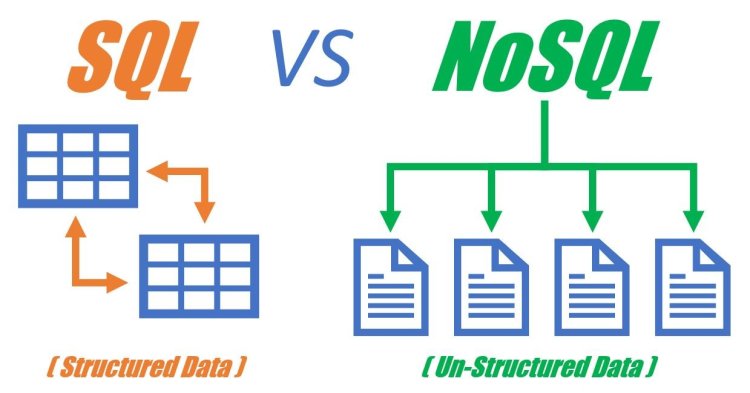SQL vs. NoSQL & Beyond: Choosing the Right Database for Your Web Application
SQL vs. NoSQL & Beyond: Choosing the Right Database for Your Web Application

SQL vs. NoSQL & Beyond: Choosing the Right Database for Your Web Application (March 2025 Guide)
At the heart of nearly every web application lies a database – the persistent engine storing, organizing, and retrieving the crucial data that brings your application to life. Choosing the right database is one of the most critical architectural decisions you'll make. Get it right, and your application can scale smoothly and perform efficiently. Get it wrong, and you might face performance bottlenecks, scalability nightmares, or costly migrations down the line.
As of March 2025, the database landscape is richer and more diverse than ever. Gone are the days when a single type of relational database was the default choice for everything. Today, we have a plethora of options, broadly categorized into SQL (Relational) and NoSQL (Non-Relational), along with emerging hybrid models.
So, how do you navigate this complex terrain? There's no single "best" database – the ideal choice depends entirely on your application's specific needs and constraints. Let's break down the options and the key factors to consider.
The Stalwart: SQL (Relational) Databases
Relational databases have been the workhorse of application development for decades. They organize data into tables with predefined schemas (rows and columns) and use Structured Query Language (SQL) for data manipulation and querying.
-
Key Characteristics:
- Structured Data: Enforces a strict schema before data insertion.
- ACID Compliance: Guarantees Atomicity, Consistency, Isolation, and Durability, ensuring transaction reliability. This is crucial for financial transactions or systems where data integrity is paramount.
- Relationships: Excellently handles complex relationships between data entities using joins.
- Mature Technology: Well-understood, widely supported, with a vast ecosystem of tools and expertise.
-
Pros: Strong data consistency, data integrity enforced at the database level, powerful querying capabilities, mature ecosystem.
-
Cons: Can be less flexible with evolving data structures (schema changes can be complex), horizontal scaling can be more challenging/expensive compared to some NoSQL options.
-
When to Choose SQL:
- Your data is highly structured and relationships are well-defined.
- Data consistency and transactional integrity (ACID) are non-negotiable (e.g., financial systems, booking systems).
- You need to perform complex queries involving multiple tables (joins).
- Your team has strong SQL expertise.
-
Popular Examples: PostgreSQL, MySQL, MariaDB, Microsoft SQL Server, Oracle Database, SQLite (for simpler/embedded use cases).
The Flexible Contender: NoSQL (Non-Relational) Databases
NoSQL emerged to address the limitations of relational databases, particularly concerning scalability, performance for specific workloads, and handling unstructured or rapidly changing data. It's an umbrella term encompassing various database models.
-
Key Characteristics:
- Flexible Schema: Often schema-less or schema-on-read, allowing for diverse data structures within the same collection.
- Scalability: Generally designed for easier horizontal scaling (distributing data across multiple servers).
- Performance: Can offer high performance for specific query patterns (e.g., simple key lookups, large data writes).
- BASE Properties (Often): Prioritizes Basically Available, Soft state, and Eventual consistency over strict ACID compliance in distributed environments.
-
Main NoSQL Categories:
- Document Databases (e.g., MongoDB, Couchbase): Store data in document-like structures (e.g., JSON, BSON). Good for content management, catalogs, user profiles where data structure varies.
- Key-Value Stores (e.g., Redis, Memcached): Store simple key-value pairs. Extremely fast for caching, session management, leaderboards.
- Column-Family Stores (e.g., Apache Cassandra, HBase): Store data in columns rather than rows. Optimized for heavy write workloads and querying large datasets by column. Good for time-series data, IoT, analytics.
- Graph Databases (e.g., Neo4j, Amazon Neptune): Focus on relationships between data points (nodes and edges). Ideal for social networks, recommendation engines, fraud detection.
-
Pros: High scalability, schema flexibility, potentially lower cost for horizontal scaling, high performance for specific use cases, good for unstructured/semi-structured data.
-
Cons: Eventual consistency might not be suitable for all applications, querying can be less powerful/standardized than SQL across different models, managing diverse data models can add complexity.
-
When to Choose NoSQL:
- You need to handle large volumes of unstructured or semi-structured data.
- High scalability (especially horizontal) and availability are top priorities.
- Your application requires very high read/write throughput.
- Schema flexibility is crucial due to rapidly evolving requirements.
- Your use case maps well to a specific NoSQL model (e.g., graph data, caching).
Key Factors to Guide Your Decision
Choosing isn't just about SQL vs. NoSQL. Ask yourself these questions:
- Data Structure: Is your data highly structured, semi-structured, or unstructured? How likely is the structure to change? (SQL prefers structure; NoSQL offers flexibility).
- Scalability Needs: How much data do you anticipate? How many users? Do you need high read, write, or balanced throughput? Do you need to scale vertically (bigger server) or horizontally (more servers)? (NoSQL often scales horizontally more easily for certain workloads).
- Consistency Requirements: Is immediate consistency (ACID) essential for every transaction, or can you tolerate eventual consistency (BASE)? (SQL guarantees ACID; many NoSQL options prioritize availability/partition tolerance).
- Query Complexity: Will you need complex joins and aggregations across different data types, or primarily simple lookups and updates? (SQL excels at complex queries; NoSQL models are optimized for specific query patterns).
- Team Expertise: What databases is your development team familiar and comfortable with? The learning curve for a new database type can impact development speed.
- Performance Needs: What are the latency requirements for reads and writes? (Specific database types are optimized for different performance characteristics – e.g., Redis for low-latency reads).
- Budget & Operations: Consider licensing costs (open source vs. commercial), infrastructure costs, and operational overhead. Managed cloud database services (like AWS RDS, Azure SQL DB, Google Cloud SQL, MongoDB Atlas, etc.) can simplify operations but have associated costs.
- Ecosystem & Community: How mature is the database? Is there good community support, documentation, libraries for your programming language, and robust tooling?
Beyond the Binary: Hybrid Approaches & NewSQL
- Polyglot Persistence: It's increasingly common for complex applications to use multiple databases. You might use a relational database for core transactional data, a key-value store for caching, and a document database for product catalogs – choosing the best tool for each specific job.
- NewSQL / Distributed SQL: Databases like CockroachDB, TiDB, or Google Spanner aim to combine the scalability and resilience of NoSQL with the ACID guarantees and SQL interface of relational databases. They are powerful but can be complex to manage.
Conclusion
Choosing a database in 2025 is about carefully matching the technology to your specific problem domain. Don't fall into the trap of choosing based purely on hype or familiarity.
- Analyze your application's requirements deeply: data structure, scale, consistency, query patterns.
- Understand the trade-offs between different database models (SQL, Document, Key-Value, etc.).
- Consider operational factors like team expertise, cost, and managed services.
- Don't be afraid to use multiple databases if different parts of your application have distinct needs (Polyglot Persistence).
- Prototype and test if unsure, especially for performance-critical aspects.
By taking a thoughtful, requirement-driven approach, you can select the database (or databases) that will serve as a solid foundation for your web application's success, both now and as it grows.
What's Your Reaction?














